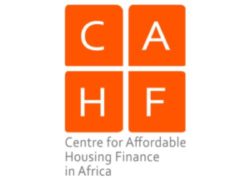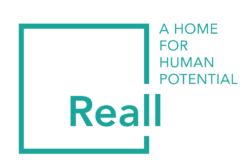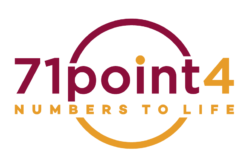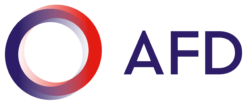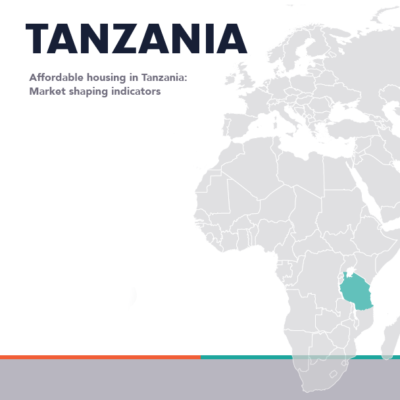Tanzania - Market Shaping Indicators
View Reall projects in TanzaniaTanzania has been one of CAHF’s priority countries since 2015. Working with the TMRC as a primary partner, CAHF has undertaken multiple research projects, while developing a solid network of stakeholders across multiple sectors. Together with the Tanzania yearbook profile, CAHF’s research is an important input into the broader Data Agenda work in Tanzania identifying key gaps in housing market data that would help create a better understanding of the housing ecosystem, for more targeted interventions and policy.
Country Overview
Tanzania’s housing sector is faced with a number of constraints, affecting its ability to provide affordable accommodation. In Tanzania, a large number of houses are built informally, often in unplanned settlements, and most households take multiple years of incremental saving and building. Low incomes affect housing affordability and household access to formal financial products. Rapid urbanisation and projected growth in urban households will require consistently larger numbers of more affordable housing units.
In Tanzania, the role of the state in housing delivery is two-fold, creating an enabling environment and actively investing in developing properties . The National Housing Corporation (NHC), a government entity established to undertake various real estate activities, develops houses for purchase or rental, with houses for purchase on a tenant purchase system, mortgage, or cash payment . Ongoing projects undertaken by the NHC include Morocco Square, Kawe, SafariCity, Golden Anniversary, Iyumbu Satellite Centre and My Home My Life. Completed NHC projects include Victoria Place, EcoResidence, Mwongozo, Kigamboni Mchikichi, 274Chato, Medeli, Levolosi, Shangani, Rahaleo, Meru Residential and Rahaleo Complex.
The Tanzania Housing Finance Project (HFP) (2010-2019), through which the TMRC was established, has been fundamental in providing liquidity to the mortgage market, and subsequently expanding access to adequate and affordable housing. This project has made commercial mortgage terms more favourable, and leveraged microfinance institutions to increase the availability of specialised loan products expanding Tanzania’s housing finance market overall .
State of Housing Data
Data is collected by various government and non-government actors. The National Bureau of Statistics and the BOT are the main sources of quality data on housing and housing finance. The data is published through printed media, and includes household data, financial sector and mortgage market data, real estate development data, labour market data and macroeconomic data, among others. The Tanzania Building Agency, National Construction Commission, National Housing Corporation, Tanzania Investment Centre, Ministry of Lands, Tanzania Bankers Association and Tanzania Mortgage Refinancing Company play key roles in data collection and management. There is, however, a need to enhance the range of data available.
The main quality concerns relating to sales, transfer, and rental indicators relate to the interpretability, representativeness, and accessibility of the data. Quality improvements will require sourcing more representative rental and house price data. The Association for Real Estate Professionals in Tanzania (AREPTA) and the BOT/TMRC mortgage market updates are potential avenues through which these gains can be realised. Private sector institutions such as Zoom Tanzania and housing developers (the NHC and WHC) are also key to the housing data ecosystem. There is also limited published data on the functioning and performance of the low- and middle-income residential markets. Quality improvements are also possible for indicators relating to house construction if the BOT and NBS enable a housing specific focus in their published loan and national accounts data, respectively.
In some instances, closing data gaps and improving data quality merely requires dissemination of data that is already collected. In other cases, more detailed scoping and engagement with data curators is required to get a better understanding of the data landscape of certain market players. There are a number of opportunities to close key data gaps, improve access to data and enhance the quality of data that is provided in Tanzania. Targeting regulators, given their existing data collection role, to share data in the public domain would be a first and critical step in supporting a more comprehensive and investment-supportive housing data landscape.
Text on this page is based on the MSI Tanzania Country Profile , drawn from Centre for Affordable Housing Finance (2020). Housing Finance in Africa Yearbook: 11th Edition 2020 , with additional content from CAHF and Reall.
Key Indicators
1. Land & Infrastructure
% of urban bottom 40 households without access to basic sanitation services
| Country | Year | Data Source | Value |
|---|---|---|---|
| Cote d'Ivoire | 2012 | DHS | 96.5% |
| Ghana | 2014 | DHS | 93.15% |
| Kenya | 2014 | DHS | 88.25% |
| Morocco | 2004 | DHS | 52.05% |
| Mozambique | 2011 | DHS | 95.6% |
| Nigeria | 2018 | DHS | 83.1% |
| Tanzania | 2017 | DHS | 37% |
| Uganda | 2016 | DHS | 94.5% |
| Rwanda | 2016 | National Institute of Statistics Rwanda (NISR) | 13.13% |
| Pakistan | 2018 | The DHS Program | 2.75% |
| India | 2018 | NSSO 76th Round | 0.2% |
2. Construction & Investment
% of urban population living in slums, informal settlements, or inadequate dwellings
| Country | Year | Data Source | Value |
|---|---|---|---|
| Cote d'Ivoire | N/A | ||
| Ghana | N/A | ||
| Kenya | N/A | ||
| Morocco | N/A | ||
| Mozambique | N/A | ||
| Nigeria | N/A | ||
| Tanzania | N/A | ||
| Uganda | N/A | ||
| Rwanda | 2018 | World Bank | 42.1% |
| Pakistan | N/A | ||
| India | 2018 | NSSO 76th Round | 35% |
3. Sales & Rental
Number of residential mortgages outstanding
| Country | Year | Data Source | Value |
|---|---|---|---|
| Kenya | 2019 | Central Bank of Kenya | 27,993 |
| Nigeria | 2019 | NMRC | 32,260 |
| Tanzania | 2019 | Bank of Tanzania and Tanzania Mortgage Refinance Company Limited | 5,460 |
| Rwanda | 2020 | National Bank of Rwanda (NBR) | 44,177 |
| Pakistan | 2019 | State Bank of Pakistan - Housing Finance Data Review | 58,620 |
| India | 2020 | Reserve Bank of India | 9,817,180 |
3. Sales & Rental
Price of the cheapest, newly built dwelling by a formal developer or contractor
| Country | Year | Data Source | Value |
|---|---|---|---|
| Cote d'Ivoire | 2018 | Site d'annonce et promotion dans l'immobilier en Côte d'Ivoire | 15,500,000 CFA$27,087.48 |
| Ghana | 2019 | Damax Construction Co. Ltd | 108,704 GH₵$19,621.66 |
| Kenya | 2019 | Tsavo Real Estate | 4,000,000 Ksh$37,037.04 |
| Morocco | 2019 | Various real estate websites | 250,000 DH$27,027.03 |
| Mozambique | 2016 | Casa Minha | 3,418,491 MZ$48,147.76 |
| Nigeria | 2019 | Millard Fuller Foundation; Shelter Origins | 2,900,000 NGN$7,651.72 |
| Tanzania | 2018 | CAHF | 37,966,107 TZS$16,508.58 |
| Uganda | 2019 | Various property developers | 125,000,000 UGX$34,097.11 |
| Rwanda | 2020 | Marchal Real Estate Developers | 10,000,000 R₣$11,119.14 |
| Pakistan | 2021 | Partners | 2,500,000 PKR$14,305.33 |
| India | 2022 | Real estate websites and industry experts | 160,000 IN₹$2,176.87 |
3. Sales & Rental
% of national households that rent their dwelling
| Country | Year | Data Source | Value |
|---|---|---|---|
| Ghana | 2017 | Ghana Statistical Service | 28% |
| Kenya | 2019 | Central Bank of Kenya, Kenya National Bureau of Statistics, FSD Kenya | 35.01% |
| Morocco | 2014 | High Commission for Planning; World Bank | 18.5% |
| Nigeria | 2018 | World Bank; Nigeria National Bureau of Statistics | 21.8% |
| Tanzania | 2017 | National Bureau of Statistics | 80.56% |
| Uganda | 2016 | DHS | 53.45% |
| Rwanda | 2020 | Access to Finance Rwanda (AFR) and National Institute of Statistics Rwanda (NISR) | 8.94% |
| Pakistan | 2017 | Population and Housing Census | 11.53% |
| India | 2018 | NSSO 76th Round | 13% |
5. Enabling Environment
Ease of Doing Business Index Rank: Global
| Country | Year | Data Source | Value |
|---|---|---|---|
| Cote d'Ivoire | 2020 | World Bank | 110 |
| Ghana | 2020 | World Bank | 118 |
| Kenya | 2019 | World Bank Ease of Doing Business | 61 |
| Morocco | 2020 | World Bank | 53 |
| Mozambique | 2019 | World Bank | 74 |
| Nigeria | 2020 | World Bank | 131 |
| Tanzania | 2020 | World Bank | 141 |
| Uganda | 2020 | World Bank | 116 |
| Rwanda | 2020 | World Bank Ease of Doing Business Indicators | 38 out of 190 |
| Pakistan | 2020 | World Bank Doing Business Indicator | 108 out of 190 |
| India | 2020 | World Bank | 63 out of 190 |
6. Economic Environment
GDP Per Capita
| Country | Year | Data Source | Value |
|---|---|---|---|
| Cote d'Ivoire | 2018 | World Bank | 1,024,171 CFA$1,789.82 |
| Ghana | 2019 | World Bank | 11,489 GH₵$2,073.83 |
| Kenya | 2018 | World Bank | 173,272 Ksh$1,604.37 |
| Morocco | 2018 | World Bank | 30,725 DH$3,321.62 |
| Mozambique | 2018 | World Bank | 30,772 MZ$433.41 |
| Nigeria | 2018 | World Bank | 659,159 NGN$1,739.21 |
| Tanzania | 2018 | National Bureau of Statistics; World Bank | 2,297,020 TZS$998.80 |
| Uganda | 2018 | World Bank | 2,357,327 UGX$643.02 |
| Rwanda | 2019 | World Bank | 737,578.59 R₣$820.12 |
| Pakistan | 2020 | World Bank National Accounts Data | 188,900 PKR$1,080.91 |
| India | 2020 | Ministry of Statistics and Program Implementation | 151,760 IN₹$2,064.76 |
7. Demand
Population Size
| Country | Year | Data Source | Value |
|---|---|---|---|
| Cote d'Ivoire | 2017 | World Bank | 24,437,469 |
| Ghana | 2019 | World Bank | 30,417,856 |
| Kenya | 2017 | World Bank | 50,221,473 |
| Morocco | 2017 | World Bank | 36,471,769 |
| Mozambique | 2018 | World Bank | 29,495,962 |
| Nigeria | 2017 | World Bank | 190,873,311 |
| Tanzania | 2019 | World Bank | 58,005,463 |
| Uganda | 2017 | World Bank | 41,487,000 |
| Rwanda | 2019 | World Bank | 12,626,950 |
| Pakistan | 2020 | World Bank National Accounts Data | 220,892,331 |
| India | 2021 | Minsitry of Health and Family Welfare | 1,361,343,000 |
All Indicators
Please enter 3 or more characters to begin search.
You can then click on a result to be taken to the relevant tab.
The Market Shaping Indicators project is a work in progress. Significant gaps exist in data, which will be filled in future revisions. We would recommend checking back regularly for updates. We are keen to receive any feedback that you have on this Dashboard, which can be sent to [email protected].
Using the Dashboard
The indicators are split into 6 key areas, split into the Housing Value Chain: Land & Infrastructure, Construction & Investment, Sales & Rental, Maintenance & Management, Enabling Environment, Economic Environment and Demand, shown in the following tabs. Navigation can either be undertaken by using the tabs, or through the Search box immediately above. Above this, currency indicators can be toggled between USD and local currency.
Users are able to further interrogate each indicator each indicator through clicking on the arrows to the left of each indicator. This expanded section shows the data elements that are used to produce the overall indicator value, dates of data collection, source details, hyperlinks to the original data where possible, and a breakdown of data quality. The majority of indicators are quality assessed, based on the whether they are: Interpretable; Relevant; Sufficiently Accurate; Representative; Timely; and Accessible. Indicators are scored on each of these criteria using a 1-4 star system, detailed below:
☆ – poor
☆☆ – moderate
☆☆☆ – good
☆☆☆☆ – excellent
Finally, all data can be downloaded for further interrogation. By clicking on Switch to Data View at the top of the screen, users can filter data based on countries and columns, and download in a .csv or .xls file.
Bottom 40
Reall targets the Bottom 40% of the urban income pyramid, referred to as the ‘Bottom 40’ or ‘B40’. An objective of the MSI work was to better understand and demonstrate the market from the perspective of households in the Bottom 40, and as such data is aggregated for this group where possible. Data for this group can be particularly challenging to come across. In part, this is due to the difficulties in accurately defining this group using existing data sets. Additionally though, the informality of much of life for lower income groups severely limits data availability, particularly in terms of key data on jobs, housing and relationships with local government. This lack of data is a key blockage for further engagement at the lower end of the housing market, and resolving this is an objective of Reall’s and of the MSI work.
Aggregations
Data is shown at various different “aggregations”, which demonstrate the size and location of the population for which the data represents. This varies from national to city level in terms of population groupings. Additional aggregations exist for the Bottom 40, as detailed above, enabling a focused view on the lower end of the market.
For relevant data, Reall’s partners are also included as an aggregation. This is not meant to be representative of the entire market, but recognises that as practitioners and experts within the lower end of the housing market of each country, their experiences are a useful check on other data sets, and an indication of the value when other data is not available.
Terms of Use
Reall Ltd (“Reallâ€) endeavours to make its data as freely available as possible in order to demonstrate the successes of its model and encourage other actors into the affordable homes movement. Reall provides the user with access to these data free of charge subject to the terms of this agreement.
Users are encouraged to use the data to benefit themselves and others in creative ways.
Unless specifically labelled otherwise, you are free to copy, distribute, adapt, display or include the data in other products for commercial or non-commercial purposes for no cost under a Creative Commons Attribution 4.0 International License, with the additional terms below.  The basic terms may be accessed here. By using or downloading the data, users are agreeing to comply with the terms of a CC BY 4.0 licence, and also agreeing to the following mandatory and binding additions:
– You agree to provide attribution to Reall in any published use of the data, including but not limited to articles, papers, blogs, books. Usage includes both direct publication of the existing data, along with any analysis undertaken by the user. This attribution should include Reall’s name and the following link – reall.net/dashboard. An electronic copy of all reports and publications based on the data should be shared with Reall ([email protected]).
– When sharing or facilitating access to the data, you agree to include the same acknowledgement requirement in any sub-licences of the data that you grant, and a requirement that any sub-licences do the same. You may meet this requirement by providing the uniform resource locator (URL) to these terms of use.
– Some datasets and indicators may be provided by third parties, and may not be redistributed or reused without the consent of the original data provider, or may be subject to additional terms and conditions. Where applicable, third party data is labelled as such, and usage conditions can be found on their respective websites.
Land
All land in Tanzania is public land whether granted, customary or unoccupied. Tanzania has a central lands title deeds registry, but the level of automation is low. The country is in the process of implementing an integrated land management information system to support digitised land tenure and title system. Tanzania registered and issued titles to 47 948 parcels of land in 2019 compared to 41 522 in 2018, and 21 743 in 2017. There are 722 346 properties with a title deed in Tanzania, less than 6% of the 12.3 million households.
According to a 2019 report by the National Bureau of Statistics, approximately 64 percent of the population believe that their properties are tenure secure; however, security levels on ownership and use of property remain low among renters, at 37 percent . Tanzania scores low (145th of 190 countries) in the World Bank s quality of land administration index which measures reliability of infrastructure, transparency of information, geographic coverage, land dispute resolution, and equal access to property rights. The National Land Policy of 1997 is under review to provide more impetus in addressing land disputes, surveying and mapping, titling of land, security of land tenure, payment of compensation for land acquired by the state, promoting investment, and ensuring equitable access to land.
Infrastructure
Almost half of the population were living in households without access to drinking water services and 57 percent without access to basic sanitation services, in 2017. For the bottom 40 percent of the urban population, 44 percent were living in households without access to basic drinking water services, and 37 percent without access to basic sanitation services. All of the urban bottom 40 population had no access to electricity. When comparing urban and rural Tanzania, the lack of access to basic amenities is more pronounced for rural households. Access to basic infrastructure is limited and poor households, in particular, experience significant barriers in accessing essential services. Other key amenities such as urban transport services and dwelling location affect mobility, accessibility and result in trade-offs in housing expenditure, which varies by income. Approximately thirteen percent of household budgets are spent on transport.
Of the 23 indicators in this group, 6 are currently populated.
Tanzania has 138 registered private developers/ contractors. The number of dwellings completed annually is not readily available, but in 2019, 26 408 formal units are reported to have been built. The total number of formal residential dwellings was estimated to be 4.8 million in 2017, out of a total of 12.3 million households.
The use of modern materials for construction increased over the 1991-2018 period. Households with modern walling increased from 16 percent to 79 percent, households with modern flooring from 21 percent to 51 percent, and households with modern roofing from 35 percent to 64 percent. Dwellings in urban areas appear to be in better condition than in rural areas, as 70 percent of households in rural areas had improved walls compared to 94 percent in urban areas, while only 77 percent of households in rural areas had improved roofs compared to 98 percent in the urban areas. Only 32 percent of rural households had improved floors compared to 85 percent in urban areas .
The cost of a standard 50kg bag of cement has remained steady in the last year, at approximately TSh14 000 (US$6). This is compared to Uganda (US$7.50), Kenya (US$5.45), Nigeria (US$5.83) and Mozambique (US$6.42). However, in Tanzania, this cost varies across and within urban areas. The average cost of labour is approximately TSh20 000 (US$9) a day, but this also varies across levels of skill and type of profession.
Of the 19 indicators in this group, 8 are currently populated.
Property Markets
A small proportion (11 percent) of Tanzania s population own their dwellings, though for the urban bottom 40 this increases to 82 percent.
Property markets in urban areas are dominated by the private sector, which has a market share of over 75 percent. Some of the key industry bodies for developers are the Association of Citizen Contractors Tanzania and the Association of Real Estate Professionals in Tanzania, which was the Tanzania Institution of Valuers and Estate Agents until 2019.
The real estate sector grew by 4.5 percent in 2019 compared to 4.4 percent in 2018 . The sector faces various key housing issues including containing the pressure of rapid urbanisation, which has increased the demand for housing and led to a housing deficit due to inelastic housing supply. This has been exacerbated by outdated master plans, unplanned settlements, land conflicts, poor infrastructure limiting mobility, and poor supply of housing amenities such as water, sanitation and energy services .
Mortgages
Housing finance in the country ranges from mortgages to personal loans. The proportion of the adult population that borrowed formally was only 12 percent in 2017. Between 2019 and 2020 the number of banks offering mortgages increased to 32 from 31, and five lenders dominated the mortgage market, with a 69 percent share ³. The number of actors appears inconsistent with the number of mortgages though, with just 5 460 outstanding mortgages in the country in 2019. However, this is still a significant increase from 2018, when the number was 4 996. The monetary value of the outstanding mortgages amounted to TSh464 billion (US$200 million) in 2020, an average of TSh78.5 million (US$34 000) per mortgage. Down payments are typically 10 percent of the value of the house to be constructed or bought ´, with interest rates of 15-19 percent and a typical mortgage term of 20 years.
Housing financing by non-banking institutions is associated with four active registered housing cooperatives in 2018, whose members shares amounted to TSh890 million (US$384 000): see link.
Affordability
The typical monthly rental in an urban area for the cheapest newly built house is approximately TSh300 000 (US$130). The urban bottom 40 percent of Tanzania s population would only afford less than half of the typical monthly rental “ TSh144 200 (US$62.2), and a maximum house price of approximately TSh9.7 million (US$4 222) based on currently available housing finance products.
Of the 40 indicators in this group, 16 are currently populated.
Microfinance loans support the low income segment of the market, who construct, improve or renovate their homes incrementally. These loans can bridge the gap in housing finance, given limited access to the mortgage market by poorer households. In 2019, there were 460 microfinance loans (not limited to housing), valued at TSh240 million (US$103 500). These loans were disbursed by two out of the five registered microfinance institutions (EFC Tanzania Microfinance Bank and Yetu Microfinance Bank) . However, EFC, Hakika Microfinance Bank and Mwanga Community Bank have since merged . Tanzanian households spend 6 percent their household expenditure on home improvements.
Of the 6 indicators in this group, 4 are currently populated.
Use of banking services by the population is low, with only 12.3 percent of households having at least one member with a bank account, ranging from 6.1 percent of rural households, to 23.8 percent of urban households . However, Tanzania has the largest mobile money market on the continent and mobile money platforms have enabled greater financial inclusion over the years. In 2019, mobile money transactions were worth US$57 billion, with 29.1 million mobile users. Some of the key players in this market include M-Pesa, Tigo Pesa and Airtel Money . Mobile money technologies have evolved to allow access to a range of financial services including saving, money transfers, payments and microloans.
The long-term financing provided through the Tanzania Housing Finance Project has also been instrumental in encouraging banks to move down market, increasing the availability of smaller mortgage loans ³. The main funding for mortgages are customer deposits and concession loans from the Tanzania Mortgage Refinancing Company ·.
The National Housing Corporation is lobbying for value-added tax (VAT) exemptions and a subsidy on construction materials and plots, which will enhance the affordability of properties. The NHC also constructed approximately 1 459 houses in 2019 ´.
The country ranks 163rd globally in the United Nations Development Programme s Human Development Index: see link, with a score of approximately 0.53, putting Tanzania in the low human development group. However, the country s Ease of Doing Business rank improved from 144 in 2018 to 141 in 2020: see link.
Of the 6 indicators in this group, 2 are currently populated.
In 2019, the unemployment level was reported to be 2.2 percent of the labour force . The economy of Tanzania was TSh145.34 trillion (US$63.1 billion) in 2019, having grown by 5.8 percent, and this translated into a gross domestic product (GDP) per capita of approximately TSh2.6 million (US$1 122) . This growth was mainly attributed to growth in the construction sector together with agriculture, mining and quarrying, and transport activities ³. The inflation rate has improved over the last five years, from 5.6 percent in 2015 to approximately 3.46 percent in 2019, which has increased purchasing power by making commodities relatively affordable. Income levels are moderately distributed among the population, given a Gini coefficient of 40.5 in 2017: see link.
Tanzania s growth trajectory is now being challenged by the impact of the COVID-19 pandemic. Tanzania s response to COVID-19 included closing education institutions, sporting events and public meetings. However, Tanzania did not order a lockdown; establishments continued doing business, with containment measures in place that included observing basic preventive measures such as social distancing, wearing a mask, handwashing and sanitising. The government imposed mandatory self-quarantine for travellers from risk areas, banned travel by government officials, and limited travel by citizens to other countries.
Some sectors, such as tourism and hospitality, air transport and international trade were affected. In the housing sector, a moratorium on evictions was put in place and the government further responded to the impact COVID-19 had on informal settlements through public awareness campaigns.
Of the 14 indicators in this group, 10 are currently populated.
Tanzania s population was estimated at 58 million in 2019, a three percent growth . Approximately 34.5 percent of the population live in urban areas and 65.5 percent live in rural areas. Over 40 percent of the population in urban areas live in informal settlements, which are often associated with poor basic amenities. Tanzania has a population growth and urbanisation rate of 2.9 and 5 percent, respectively.
Dar es Salaam is Tanzania s largest city and the second fastest growing city, in terms of population size globally. With a population of 6.7 million, the city accounts for approximately 30 percent of Tanzania s urban population. However, urban population growth is happening in Tanzania s secondary cities as well, including Mwanza (1.1 million), Mbeya (566 000), Arusha (493 000) and Dodoma (411 000) . Given the relocation of the national capital and administrative functions to Dodoma, the city is poised for accelerated growth. In the decade ahead, rapid urbanisation will continue to put pressure on the need to adequately meet surging demand for affordable housing and basic services across Tanzania s cities, which has now been exacerbated by the COVID-19 pandemic.
Access to affordable and adequate housing shows disparities among households, by dwelling location and gender. The average household size in Tanzania is 4.6 persons, but male-headed households are bigger in size (4.9) compared to female-headed households (3.9). Rural households tend to have a larger average household size (4.9) than urban households (4.2) ³.
Of the 7 indicators in this group, all are populated.
